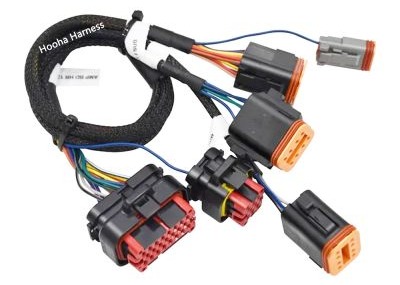How to arrange car wiring harness
Basic requirements for wiring harness layout:
(1) Wire harness trend
The wire harness should be arranged along the side/slot reserved for the car body to avoid sharp contact with the body sheet metal parts and welds.
The wiring harness arrangement should also avoid the fuel pipe and the brake pipe to avoid crossover or contact, and the wire harness has no loose and loose displacement.
For the area where the outer diameter of the wire harness is thick, the branch nodes of the wire bundle maintain a minimum spacing of 30-50 mm.
The gap between the wire harness and the static part of the vehicle shall be at least 15mm; the switch and moving parts such as the pedal, seat, steering switch and other active areas in the cockpit should fully consider the actual active travel of each part to ensure the clearance is 20-40mm.
(2) Design of wire harness fixing points
A fixed point must be set at the corner of the wire harness;
The wire harness runs straight and has no interference, and the buckle spacing is usually 150-250mm, such as the ceiling harness, the wiring harness in the cockpit, etc.;
For the wire harness of the inline part and the vibration area, a fixed point is required, and the fixed point is about 150 mm from the sheath;
The ferrule hole of the buckle on the adapter harness can be prevented as far as possible or the eyelet that prevents the buckle from rotating, and the harness can be effectively prevented from being dragged;
The working area of the sheet metal hole is also related to the convenience of the overall assembly and disassembly of the wire harness. Therefore, if the working area of the sheet metal hole is too small, it needs to be timely fed back to the unit of the general layout or related system.

(3) How to choose a buckle
The structure of the buckle is related to the fixing strength and operability of the wire harness. If the outer diameter of the wire harness is within 25 mm, the waist buckle of 7*12 is preferred. The spacing and type of the buckle need to be combined with the actual use environment and application of the wire harness. Strength requirements;
(4) Temperature resistance and electromagnetic compatibility
As the hardware carrier of the electric vehicle, the wiring harness must consider the temperature protection and electromagnetic compatibility of the wire harness in different working environments.
In the engine compartment, the heat source such as the harness and the exhaust pipe, the inverter, the heating pipe, and the charger should be kept at a distance of 160 mm or more. The cover of the wire harness surface can be selected as a bellows, and the inner wire of the wire harness can be selected as a high temperature resistant wire, and the inside of the wire harness can be selected. The splice is prevented from appearing here to prevent the heat shrinkable tube from being melted by heat;
The harness must be equipped with corresponding anti-electromagnetic interference measures when passing through the control module, combination meter, audio-visual entertainment system, airbag and other signals; shielded wires can be used in the harness, and the electrical appliances around the harness can increase the shielding or increase the grounding of the casing;
(5) Connector
In the wet and dry area of the vehicle body where the harness is located, the connector in the dry area of the passenger compartment and the luggage compartment may be considered to be fixed by the tape or the card because of the bump vibration; the wet area connector outside the passenger compartment and the luggage compartment shall be Be permanently fixed and take into account the foolproof measures;
The connector in the same area is foolproof - to make a difference in structure or color;
The chassis/fender/bumper/rear enclosure connector arrangement (horizontal and vertical) fully considers the vehicle body wading height and dust and moisture resistance level
